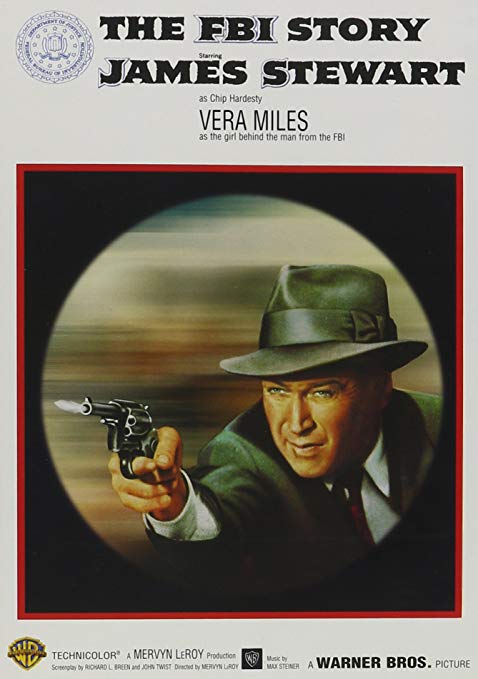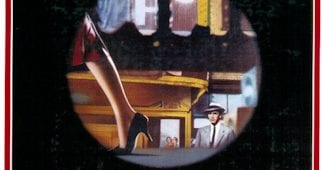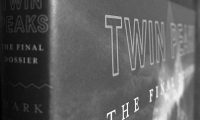Twin Peaks Backstory Investigations looks at the film and television that influenced David Lynch & Mark Frost when they created their wonderful and strange TV Show. Starting the series off is: The FBI Story
The very first autobiographical entry that thirteen year old Dale Cooper made on an audiotape, recorded December 25th 1967, featured the following statement: “Above my bed on the wall is my most important personal item, a poster of Jimmy Stewart in the movie The FBI Story which only I can touch.”
It seems fitting, of course, that in this earliest glimpse of Cooper’s documented sense of identity, there’s a kernel of the Federal Bureau of Investigation. What’s intriguing, however, is that the object embodying this kernel of himself is a movie poster–a 1959 promotional item to sell tickets to an endeavor made both for profit and to promote an ideal idea of the FBI. Put simply, Cooper’s teenage attraction to the FBI was activated by a carefully crafted work of entertainment propaganda. And the representational choices that The FBI Story circulated through the American social imaginary in the late 1950s and early 1960s can appear deeply problematic to attentive spectators today. This article investigates several critical elements of Mervyn LeRoy’s The FBI Story to identify its contradictions and elisions and put them into conversation with the character of Agent Cooper and with Twin Peaks more broadly. After all, in addition to the explicit inclusion of the film in the autobiography penned by Scott Frost, Jimmy Stewart is known to be an actor of interest to David Lynch, and Twin Peaks, as an FBI story, is a branch of an American narrative genealogy with The FBI Story deep in the family tree roots.

What likely would have been among the most attractive aspects of The FBI Story for young Dale Cooper and that continued to shape him as we know him through Season 3 is the essential transition of the Bureau when J. Edgar Hoover, played by the real J. Edgar Hoover, took the role of Director. In the early part of the film Chip Hardesty, played by Jimmy Stewart, proposes marriage to Lucy, played by Vera Miles, and she accepts on condition he resign from the Bureau and put his hard-earned law degree to work as an attorney. Although a significant part of Chip is committed to the Bureau, he agrees because he’s sorely disillusioned by what he considers the incompetence, laziness, and petty politics of people like his supervisor, Harry Dakins, played by Parley Baer.
Just before he submits his resignation letter, however, Hoover becomes Director and calls a meeting in Washington, D.C. In Hoover’s speech to Bureau members, he addresses all of the things that have frustrated Chip about the organization. Hoover emphasizes that from now on the Bureau will transition to a machine-like organization that will be known for its efficiency and competence. As a small yet symbolic example, Hoover says that from now on the Federal Bureau of Investigation will be called the more efficient acronym, the FBI. It’s hard not to perceive an intriguing resonance between this moment of the 1959 film and the moment in Season Three of Twin Peaks when Chief of Staff Denise Bryson waxes purple to Gordon Cole about how enjoyable it is to say the full name of the Bureau out loud.
Hoover concludes this same speech by stating that he is making these massive changes to FBI culture out of a commitment to policing for safety and justice. Chip is so inspired by the speech, that he doesn’t submit the resignation letter he’d brought in his suit coat pocket. This decision generates some friction with his newlywed partner, Lucy, but in woeful 1950s fashion, she brackets her own aspirations and anxieties and enables Chip to dissolve his agreement to the condition for marriage.
In terms of the commitment to policing for safety and justice, the appeal to Dale Cooper is crystal clear. These twin values are dear to him throughout his autobiography, and we see them direct his work throughout the three seasons and one film of Twin Peaks. In terms of the relationship dynamic and its unswervingly patriarchal structure, these, too, seem to have gotten coded into the character DNA of Dale Cooper. His relationships with Caroline Earle and Annie Blackburn tragically manifest some of the deep anxieties that Lucy and Chip grapple as they try to navigate a married with children life, particularly once the FBI gets legal permission to arm its agents. Also of interest is how the recuperated Coop leaves behind Janey-E and Sonny Jim so shortly after closing his coma episode by declaring, “I am the FBI.” That Cooper hands a pinch of follicle DNA to MIKE to manufacture a new Dougie attests to a core contradiction in his character. He holds two fantasies: one of being a good father, the kind who doesn’t stand there and get bonked while playing catch with a baseball, and one of being an efficient and competent police officer for safety and justice. The resolution to this instance is a positive doppelganger–a literal doubling of himself so that each individual can pursue a singular objective and not live a life torn by competing and antagonistic desires. In light of the mysteries that remain concerning Cooper and Laura Palmer/Carrie Page, his actions towards Janey-E and Sonny Jim leave a lot of room for ethical assessment.

In The FBI Story, late in the film Chip is challenged by Lucy taking their children and moving back to her parents’ house in what may have passed for a gesture of gender equity in 1959, but she ultimately realizes that she doesn’t know how to live without him and capitulates to reuniting the family. To be sure, she finds an un-posted letter in which Chip admits to missing her terribly, but it’s a minimal gesture within a story about a man’s commitment to police ideals taking precedence over love and family.
Quickly now, before pivoting to other parts of the film, it’s worth mentioning that the scene where we experience Chip interacting with the initial supervisor, Harry Dakins, who disappoints him, echoes in another profound way with Twin Peaks. As Chip enters the open-plan office space, he has to move awkwardly around the ladder of a repairman working on a ceiling fan. Not just a ceiling fan, but the one and only ceiling fan in the office, and it’s an extended sort of gag that Dakins has been spending his valuable work time writing at least six letters to the Washington office requesting a new fan to prevent them from overheating. To each attempt Chip makes to get Harry’s permission to act on a legitimate case of voter disenfranchisement, the fan is brought back as the only issue that can motivate Harry. So, without overreaching on interpretations, I point out the scene as a potential instance of how a detail that might feel like an innocuous MacGuffin could get into the DNA of a narrative realm, like FBI stories.
The other part of The FBI Story that really rings a Twin Peaks bell is a segment that follows Chip being posted to Oklahoma to investigate a series of murders. Specifically, Native American people in communities newly made very wealthy through property and mineral rights to oil-rich lands are being murdered. On the one hand, the motivations behind the violence Chip is trying to curtail are the same as the narrative driving motivations in the town of Twin Peaks. Chiefly, land ownership and development as well as manipulation of ledger-keeping, life insurance, and inheritance. On the other hand, the depictions of Native Americans in the 1959 film are deplorable. Through voice-over exposition accompanying visual documentation, Chip ridicules several Native Americans for their nouveau riche extravagances, framing their fripperies as indications that Indigenous people simply don’t know what on Earth to do with money. Chip, and thus the film, deliver a depiction of Native Americans as ossified, unchanging, and as a result vulnerable to clever white men’s schemes. The case closes with a clear focus on the white male banker behind the murders being arrested while those who lost lives and capital have already faded into the backdrop.
This racist representation is not unusual for its era, though that does not excuse it one bit. It’s important to register the history of racist portraits of Native Americans in cinema, as has been excellently done in Neil Diamond’s 2009 documentary film, Reel Injun. Such work gives texture to the role Michael Horse’s Tommy “Hawk” Hill has brought to Twin Peaks as well as the way the series leverages Indigenous artwork on the interiors of the Great Northern Hotel yet elides the history of settler-colonial murder and displacement as backstory to the Martell, Packard, Horne, and other families. Mark Frost’s The Secret History of Twin Peaks does, in fact, delve a bit into this first instance of murderous land acquisition, but it never makes it into the cinematic, and for some, canonical, Twin Peaks.
On a related note, in 2017, the same year that Season Three was released, David Grann published a stellar book on precisely this case: Killers of the Flower Moon: The Osage Murders and the Birth of the FBI. Totally worth a read if you like Twin Peaks, and particularly if you also want to transcend the stilted sort of Native American portraits like the ones of 1959 that still circulate perniciously today.
Now, while there are more parts of the film to explore (and I’ll leave these unmentioned, other than saying there’s a startling repression of race in the depiction of the Ku Klux Klan, as enticement to check out The FBI Story for yourself), one other part of the film that is striking is Chip’s mission to South America. This bit of The FBI Story actually contains a mixture of time signals that somewhat echoes the Lynchian aesthetic of 1990s meets 1950s in the original seasons of Twin Peaks and of temporal melanges in so many of his other works. The clothing, dialogues, and masculinities on display in this portion of the film simultaneously invoke the Ernest Hemingway of the Spanish Civil War, the Cary Grant character T.R. Devlin of Alfred Hitchcock’s Notorious, and the late 1950s vibe of Cold War Anti-Communist ideology. By contrast with Lynch’s unsettling multi-era aesthetics, The FBI Story feels like it’s thrashing about to find any and all cultural signifiers to deploy in the interest of justifying its treatment of South America as part of a global frontier that needs policing for safety and justice. That’s the outer limit of the big picture that The FBI Story acknowledges.
Twin Peaks, again by contrast, frames the FBI elements of its narrative within dimensions within dimensions that challenge the concept of frontiers that might be policed, at least by human agents.
Finally, The FBI Story ends weirdly. Chip gets in a car with his wife, daughter, and a grandchild who is playing with a novelty hat that Chip bought his own child once to compensate for being away and in serious danger on an FBI case. Prompted by the mass-produced object, he remarks, “I guess I’ll never understand how one little family can collect so much junk.” This non sequitur comes across as a Freudian slip–an utterance where the unconscious says out loud what’s normally restricted to spinning below the surface. A mystery remains for Chip, one of the most highly skilled investigating policemen in the world. A mystery of consumption, mass production, and the nuclear family. A mystery that reverberates, to my mind, through the knickknacks adorning the shelves in Nadine and Ed’s house, the fireplace mantle in the Palmer home, and throughout the domestic places in Twin Peaks.

And on the case is Special Agent Dale Cooper, whose path to becoming one of Chip Hardesty’s progeny all started with a mass produced bit of movie industry marketing. These FBI stories in a loop, but a loop that repeats each time with differences.




